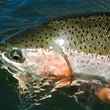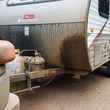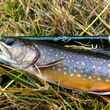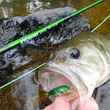The Thomas & Thomas Zone came into my life like a short, pleasant fling that left me wanting more. She was a 9ft 5wt, and I only had a few weeks to get to know her. If I’m being honest, she wasn’t much to look at, but we just jived. Then she was gone, on a plane back home, and I find myself missing her terribly. Though I need not wait long to be reunited, because at around $500, even I can scrounge up enough cash to make her mine once more.
The Zone is the quintessential workhorse rod to round out the T&T lineup, and performs in a league with rods that cost nearly twice as much. With nine different models ranging from a 7’ 6” 3wt to a 9’ 10wt, there might just be a Zone for everyone.
What works
Price
The Zone series offers premium performance at a price that, while not cheap, is well worth the investment. If you’re thinking about a $250-350 rod, you may want to hold off on expensive coffees and pack a lunch for a few weeks because the Zone is worth the extra cash. You’re getting everything you need from a $800-1000 rod, with nothing that you don’t. It might not have quite the level of fine detailing as a flagship model, but I’ve never met a fish with strong feelings about rod aesthetics.
Quality
With the Zone you’re getting the latest Thomas & Thomas tech for about half the price of their flagship models. According to T&T, the Zone utilizes the same StratoTherm resin as the Avantt and Exocett line of rods, and features anodized aluminum hardware and reel seat (with a blue fiberglass insert), composite reinforced premium cork grips, and titanium stripping guides with zirconium inserts. The freshwater (3wt-7wt) series features chrome single foot guides, while the saltwater (8wt-10wt) rods feature Snake Brand E-Coating Universal Snake guides. All models are rolled and built by hand right alongside T&T’s premium offerings in their Massachusetts facility, and come in quality aluminum rod tubes.
Utility
As you advance as an angler and a caster (or really with any discipline), you look for better and better gear to keep up with your progressing skill, and this usually comes with an increase in cost. If it's not clear already, the Zone is somewhat of an exception. The Zone rods are high performance tools, not status symbols, and their utilitarian-leaning concept is aimed at those who want the best gear but don’t need the frills.
If you’re on the fence about going high-end or mid-range, you shouldn’t worry about outgrowing it. There is a much larger gap between a budget rod and the Zone, than there is between the Zone and the top of the line. If you’re the kind of person for whom price is not a factor, and who values fine wood reel seats, artistically wrapped guides, and all the other fine details, perhaps a flagship model is more your speed. If you are a function over fashion kind of person who is tough on gear, take a good, hard look at the Zone.
Action and feel
At my summer gig working at a fly outfitter on the West Branch of the Delaware, a half dozen or so shop guys and guides got to try out the Zone, and everyone loved it; “pretty sweet,” was the term used most, and these weren’t your average casters.
Though rod preference is such a subjective consideration, there are certain qualities of a rod that make it feel “better” than or comparable to others in a category. At least as it pertains to the feel of the 5wt model that I had the pleasure of testing, the Zone is right up there with the best of the best medium-fast action trout rods I have gotten my hands on. If you’re a fan of fast and medium-fast actions, you’ll love the Zone.
T&T claims that the 3-5wts are a slightly softer and gentler casting than their heavier 6-10wt counterparts, and I find the 5wt Zone to be a true medium-fast action, which I tend to prefer. It is comfortable to cast and very accurate in the 30-60 foot sweet spot, though you can easily throw a full line on the casting pond if you know what you’re doing. I’ve spent some time on the water with a 5wt T&T Avantt, and to my mind, the Zone feels very similar. With the right line, the 5wt would make an excellent dry fly rod on big water where you need to be able to perform long, accurate casts and punch through the wind. At least for my casting style, the Zone seemed to like Rio and Cortland tapers the best of what I tried. The Rio Trout LT cast effortlessly, with nice, tight loops and ultimate control. Everything I told the rod to do, it did.
What doesn’t
Appearance
While it's one hell of a fishing tool, I’m just not a fan of the Zone’s looks. A few people I’ve talked to share my sentiment, particularly the reel seat. Personally, I don’t like the blue theme. I think the look can work on a saltwater rig, but I’m just not crazy about the rod’s appearance on a trout/freshwater setup. That being said, I’d fish the Zone if it were neon pink with rainbow polka dots. It's that good. But for me, compared to the simple, classic design of other mid-priced competitors, the Zone leaves something to be desired.
Final Word
Based on my experience, the Zone competes with some of the best trout rods on the market and offers Thomas & Thomas’ latest R&D, without upcharges for potentially superfluous features. At around $500, its a solid contender with the top of the mid-priced pack, and will give most pricier rods a run for their money.
I see the Zone being a great choice for a variety of anglers - whether you fish incessantly and need a workhorse that won't break the bank, or you’re a more casual angler that can’t justify the cost of a flagship rod that will end up collecting dust half the year. In the same vein, I think the Zone is also an ideal guide rod (once you’ve had clients break a few ‘flagship’ rods, the Zone becomes an even more attractive option). Whatever your story, the Zone is an incredibly castable and controllable rod that won’t disappoint, and at a price that more people can potentially swing. While my opinion alone may not have swayed you, trying one out for yourself just might.






























Comments